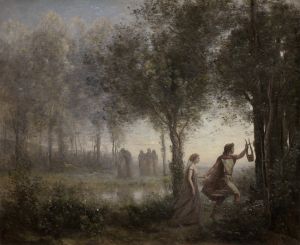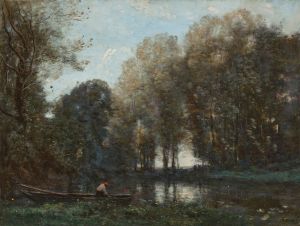
La Danse des nymphes
A hand-painted replica of Jean-Baptiste-Camille Corot’s masterpiece La Danse des nymphes, meticulously crafted by professional artists to capture the true essence of the original. Each piece is created with museum-quality canvas and rare mineral pigments, carefully painted by experienced artists with delicate brushstrokes and rich, layered colors to perfectly recreate the texture of the original artwork. Unlike machine-printed reproductions, this hand-painted version brings the painting to life, infused with the artist’s emotions and skill in every stroke. Whether for personal collection or home decoration, it instantly elevates the artistic atmosphere of any space.
Jean-Baptiste-Camille Corot's "La Danse des Nymphes" is a celebrated painting that exemplifies the artist's mastery in capturing the ethereal beauty of nature and mythological themes. Corot, a pivotal figure in 19th-century French painting, is often associated with the Barbizon School, a movement that emphasized naturalism and the depiction of rural landscapes. His work laid the groundwork for the Impressionist movement, influencing artists with his innovative approach to light and atmosphere.
"La Danse des Nymphes," painted in 1850, is a quintessential example of Corot's ability to blend realism with the dreamlike qualities of myth. The painting depicts a serene woodland scene, where a group of nymphs, mythical female spirits of nature, are engaged in a graceful dance. This work is notable for its harmonious composition and the subtle interplay of light and shadow, which creates a sense of depth and movement.
Corot's use of a muted color palette, dominated by soft greens and earthy tones, enhances the tranquil and otherworldly atmosphere of the scene. The figures of the nymphs are delicately rendered, their flowing forms and gentle gestures contributing to the painting's lyrical quality. The background, with its lush foliage and dappled sunlight, reflects Corot's keen observation of nature and his ability to convey its quiet beauty.
The painting is often praised for its poetic quality, a hallmark of Corot's style. Unlike many of his contemporaries, who focused on dramatic narratives or historical subjects, Corot preferred to explore the subtler, more introspective aspects of the natural world. In "La Danse des Nymphes," he achieves a balance between the real and the ideal, inviting viewers to immerse themselves in a scene that is both familiar and fantastical.
Corot's influence on later artists, particularly the Impressionists, is evident in his treatment of light and atmosphere. His ability to capture the transient effects of light on the landscape was revolutionary, and his work is often seen as a bridge between the classical traditions of the past and the modernist innovations of the future. "La Danse des Nymphes" exemplifies this transition, showcasing Corot's skill in creating a mood that is both timeless and evocative.
The painting is housed in the Musée d'Orsay in Paris, where it continues to be admired by art enthusiasts and scholars alike. It remains a testament to Corot's enduring legacy as a painter who could convey the beauty and mystery of the natural world with unparalleled sensitivity and grace. Through "La Danse des Nymphes," Corot invites viewers to experience a moment of tranquility and wonder, capturing the imagination with his vision of a world where myth and reality coexist in perfect harmony.


















